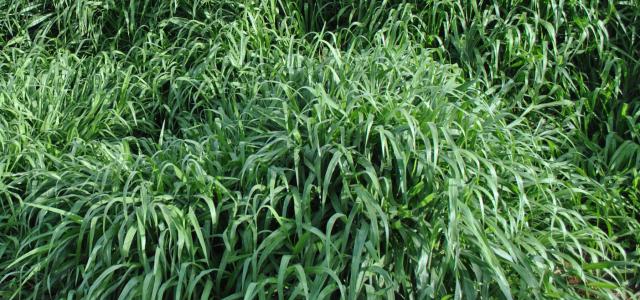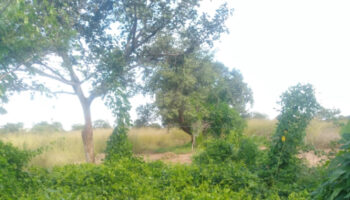Originally from Africa and bred in South America, Brachiaria grass is gaining popularity among cattle farmers in Kenya. The grass is credited with helping to revolutionalize the Brazilian beef industry. The grass has found its way to Africa, and a ready home in Kenya.
Sustainable fodder production is a constant problem facing dairy and beef farmers in Kenya. This is particularly severe in the dry season when traditional fodder grasses, like Napier cannot cope and farmers are left with no fodder for their animals. Hence, there has been continuous search for fodder grasses to ensure farmers have a consistent supply of high quality fodder for their animals, even during the dry season. Brachiaria is a grass native to Africa and other tropical regions. Now, the grass has returned to Africa, including Kenya. Two varieties of Brachiaria known as Mulato and Mulato II, are tolerant to drought, recover fast after grazing, show high plant vigour, give good quality forage and are tasty to the animals.
About Mulato
Brachiaria cv. Mulato and Mulato II are a result of breeding by the International Center for Tropical Agriculture (CIAT). According to Dr. Brigitte Maass, a forage scientist with CIAT in Kenya, Brachiaria cv. Mulato and cv. Mulato II are hybrids which have resulted from crosses involving 3 species; Brachiaria brizantha, B. decumbens and B. ruziziensis. The last one is used as a bridge. The result is a hybrid that is apomictic, meaning that the seeds produced are true breeds (their genes do not change). In reality, they are like clones of mother plant. This is an ideal situation that is not common with many crops and forages because farmers will not lose the vigor of the plant.
Growing Mulato
Mulato grows in well-drained soils of medium to high fertility with pH 5-8. Like Napier grass, it responds well to well-matured manure. It is drought tolerant and has potential to grow well in relatively drier areas of Western Kenya with mean annual rainfall of not less than 700 mm and mean daily temperatures higher than 30ᵒC. Trials conducted by KARI-Marigat show that the grass does well under irrigation in arid and semi arid areas, and under rain-fed conditions in the transitional zones.
Mulato Brachiaria is best propagated by seeds, though it can also be planted from vegetative material. Seed is the most appropriate mode of establishment for farmers who want to plant large plots of the grass. At the moment, since the seed is not yet readily available locally, farmers are advised to use vegetative propagation by cuttings. When using seed, a farmer needs 2.5-3kgs per acre. Seed is sown at the onset of rains in well-tilled seedbeds. An important feature of the Mulato Brachiaria is that its stems are capable of rooting when they come into contact with moist soil especially cause by trampling of animals. Mulato II performs very well not only in grazed systems, but also in cut and carry system.
Farmers are advised to carry out routine top dressing after every cutting or grazing; using well-matured compost, farm yard manure and rock phosphate. The grass has thick leaves, which makes it difficult for weeds to thrive.
Use of Brachiaria grass
Mulato Brachiaria can be grazed or cut and fed to animals in stalls and feedlots. Where animals graze, the duration depends on the number of animals. Sufficient time must be given to a pasture to grow back after intensive grazing. Rotational grazing will give grass time to re-grow. Where farmers cut and carry to feed the animals, the grass is ready for the next cut in about 45-50 days during the rainy season. At this stage, the grass has higher nutrient content, especially protein, than Napier.
Mulato Brachiaria has high production capacity for biomass; therefore, it is a good alternative for making silage and hay for use during the dry season. Its production and nutrient content depend on soil fertility and its management, as well as the stage of harvesting.
Farmers who have planted and used this fodder grass are impressed by its performance. Research at KARI-Kakamega and KARI-Marigat indicates that the grass holds huge potential for the dairy and beef industry in Kenya, especially in the drier areas where Napier grass does not do very well and in areas affected by the Napier stunt disease. CIAT, ICIPE and partners are exploring private partnerships to make the seed commercially available in Kenya, at an affordable price for farmers.
Brachiaria finds a home in the Push-pull system
Scientists at ICIPE, led by Prof. Zeyaur R. Khan developed Push-Pull to respond to the problem of stem borers and Striga weed in maize. The push-pull system uses Desmodium (Desmodium uncinatum), planted between rows of maize, to push the stemborer moths out of the maize field. Napier grass (Pennisetum purpureum) is planted around the maize plot to ensure that the stem borers are not able to develop to maturity. After repeated trials with different kinds of legumes ICIPE scientists found that Desmodium is more effective than other legumes in reducing striga and increasing maize yields, because it has the specific phytochemical that prevents Striga from growing longer into the maize plant.
Apart from helping farmers deal with pests, the system provides a source of fodder for cows, goats and sheep, particularly Desmodium as a protein supplement.
Wider adaptation
As the uptake of push-pull continues to increase and spread to different agro-ecologies, particularly drier areas where sorghum and finger millet thrive, a drought tolerant trap alternative to Napier grass and intercrop alternative to Desmodium is needed. This is where Brachiaria finds its place in the push-pull system. Trials conducted by ICIPE and partners show that Brachiaria cv. Mulato is tolerant to drought conditions of up to 3 months and temperatures of more than 30ᵒC. To accommodate Brachiaria, slight adjustments are made onto the system. Four rows of Mulato II are planted instead of 3 rows of Napier grass. Farmers involved in the trials get Mulato II seeds from ICIPE.
Growing popularity
Unlike Napier grass, Mulato Brachiaria does not have stinging hairs, making it easy to cut and carry. This is a quality that makes the grass attractive to farmers who use the push-pull technology to control stem borer and Striga and as a way of growing fodder for their animals.
![]()





